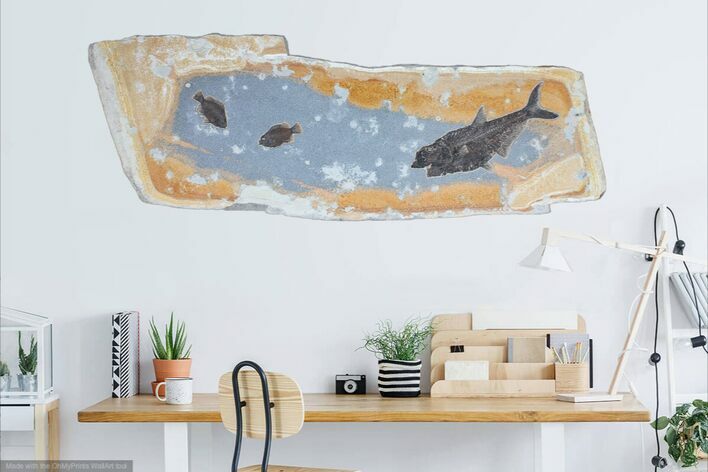This Specimen has been sold.
62" Wide Green River Fossil Fish Wall Display - Striking Rock Color
This is a spectacular fossil fish "mural" from the Green River Formation of Wyoming. It measures 62 x 23" and features three fossil fish on a very attractive, multi-colored slab of shale. The largest fish is a 19.2" long Diplomystus dentatus and there are also a pair of Cockerellites (Priscacara) liops which each measure just over 5" long.
All of the fossil fish have been inlaid into the colorful rock for display purposes. Other than the inlaying the fish have not been restored or painted. The large section of rock has been backed with wood for stability and is ready to be hung on a wall. It's a pretty heavy piece, probably weighing around 200 lbs.
Because of the size of the plate it must be shipped on a pallet via truck freight. Freight shipping costs within the continental US are included in the price. Shipping outside of the continental US is extra and will be billed after purchase. Please contact us if you need a shipping quote.
Fossil fish from the 18 inch layer split out "ghosted" underneath the surface of the rock. Typically only bumps from the back bone can be seen in faint relief against the surface of the rock. Because of this they typically collect this layer at night using high powered lighting which allow them to better see the shadows from these bumps on the rock. These fish must then be prepared removing all of the matrix from on top of them, a very meticulous and time consuming process.
All of the fossil fish have been inlaid into the colorful rock for display purposes. Other than the inlaying the fish have not been restored or painted. The large section of rock has been backed with wood for stability and is ready to be hung on a wall. It's a pretty heavy piece, probably weighing around 200 lbs.
Because of the size of the plate it must be shipped on a pallet via truck freight. Freight shipping costs within the continental US are included in the price. Shipping outside of the continental US is extra and will be billed after purchase. Please contact us if you need a shipping quote.
Fossil fish from the 18 inch layer split out "ghosted" underneath the surface of the rock. Typically only bumps from the back bone can be seen in faint relief against the surface of the rock. Because of this they typically collect this layer at night using high powered lighting which allow them to better see the shadows from these bumps on the rock. These fish must then be prepared removing all of the matrix from on top of them, a very meticulous and time consuming process.
SPECIES
Diplomystus dentatus & Cockerellites (Priscacara) liops
LOCATION
Kemmerer, Wyoming
FORMATION
Green River Formation
SIZE
62 x 23", Fish 19.2", 5.2" & 5.2", around 200 lbs
CATEGORY
SUB CATEGORY
ITEM
#104582
We guarantee the authenticity of all of our specimens.
 Reviews
Reviews















